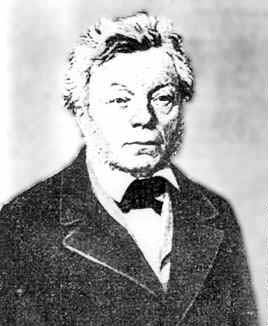Karl Georg Christian von Staudt
| Karl G. C. von Staudt | |
|---|---|

Karl von Staudt (1798 - 1867)
|
|
| Born |
24 January 1798 Free Imperial City of Rothenburg (modern day Rothenburg ob der Tauber, Germany) |
| Died |
1 June 1867 (aged 69) Erlangen |
| Residence | Germany |
| Nationality | German |
| Fields |
Astronomy Mathematics |
| Alma mater | University of Erlangen |
| Doctoral advisor | Gauss |
| Known for | Algebra of throws von Staudt-Clausen theorem |
| Influences | Gauss |
| Influenced |
Eduardo Torroja Caballe Corrado Segre Mario Pieri |
Karl Georg Christian von Staudt (24 January 1798 – 1 June 1867) was a German mathematician who used synthetic geometry to provide a foundation for arithmetic.
Karl was born in the Free Imperial City of Rothenburg, which is now called Rothenburg ob der Tauber in Germany. From 1814 he studied in Gymnasium in Ausbach. He attended the University of Göttingen from 1818 to 1822 where he studied with Gauss who was director of the observatory. Staudt provided an ephemeris for the orbits of Mars and the asteroid Pallas. When in 1821 Comet Nicollet-Pons was observed, he provided the elements of its orbit. These accomplishments in astronomy earned him his doctorate from University of Erlangen in 1822.
Staudt's professional career began as a secondary school instructor in Würzburg until 1827 and then Nuremberg until 1835. He married Jeanette Dreschler in 1832. They had a son Eduard and daughter Mathilda, but Jeanette died in 1848.
The book Geometrie der Lage (1847) was a landmark in projective geometry. As Burau (1976) wrote:
Furthermore, this book (page 43) uses the complete quadrangle to "construct the fourth harmonic associated with three points on a straight line", the projective harmonic conjugate.
Indeed, in 1889 Mario Pieri translated von Staudt, before writing his I Principii della Geometrie di Posizione Composti in un Systema Logico-deduttivo (1898). In 1900 Charlotte Scott of Bryn Mawr College paraphased much of von Staudt's work in English for The Mathematical Gazette. When Wilhelm Blaschke published his textbook Projective Geometry in 1948, a portrait of the young Karl was placed opposite the Vorwort.
...
Wikipedia
